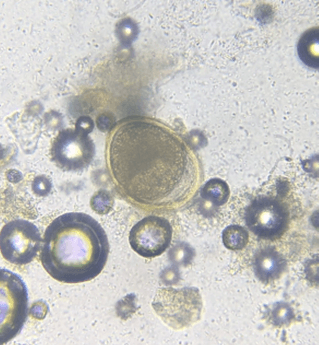
Fall aka “spooky season” is here! So it’s a fitting time to talk about the creepy-crawly part of the pet world: parasites.
Parasites are organisms that are sustained by living on or in another organism. They acquire their nutrition and/or vital life functions at the expense of another creature.
While some parasites cause minimal harm to their host (the animal they live on/in), others can cause significant health issues. Unfortunately, parasites are common in domestic animals, so every pet owner should have some basic knowledge on the subject.
Inside vs. outside
The two main categories of parasitic infections seen in cats and dogs are internal parasites and external parasites. Internal parasites live within an animal, and external parasites live on an animal. This article will focus on internal parasites.
The majority of internal parasites are types of worms that live and reproduce in the gastrointestinal tract. The most common internal parasite seen in cats and dogs is the roundworm.
Roundworm
Most puppies and kittens are born with roundworms. They can even become infected when nursing from their mother. Adult worms live in the intestines and eggs from the worms are passed in the stool. Those microscopic eggs are widespread in the environment and soil where another animal can ingest them and continue the life cycle. Roundworms feed on material in the GI tract and prevent the animal from absorbing complete nutrition.
Although not a natural host, roundworms can infect people. Handwashing and good hygiene after cleaning up stool, after gardening, and after playing in sandboxes are good means of prevention.
Hookworm
Another common internal parasite of cats and dogs are hookworms. They are also passed from mother to young during pregnancy and through nursing after birth. Ingestion of microscopic hookworm eggs and/or their larvae in the environment can result in infection.
This is another parasite that people can potentially get, though humans are an atypical host in which the hookworm can’t complete its life cycle. Good prevention is accomplished through handwashing and avoiding walking barefoot outside. Heavy burdens of hookworms in cats and dogs can lead to anemia, in addition to general malnutrition.
Tapeworm
Tapeworms are yet another internal parasite that often affects cats and dogs. There are two types of tapeworms seen regularly in pets. One is carried by fleas. When a cat or dog has fleas, they often become infected by tapeworms. When the animal grooms itself, fleas are ingested and it begins the infection process.
The other prevalent tapeworm is one that domestic pets can acquire when they eat rodents or other small mammals. Cats and dogs known to hunt small prey and/or those who have fleas should be regularly treated. Although tapeworm infection can result in malnutrition, some animals infected with tapeworms don’t exhibit any symptoms.
Luckily, they’re very treatable!
These are only a few of the many parasites that can infect cats and dogs, but some of the most common ones. The good news? All are fairly easy to treat with regular deworming medications. Basic fecal testing is available through veterinarians. Additionally, a visual exam of the animal’s stool can sometimes identify these worms. Roundworms are long and round (think spaghetti) and may be seen in stool or vomit.
Hookworms are much smaller and harder to see, but are occasionally seen in the stool. They are less than an inch long, sometimes as small as a quarter-inch, with a small hook at the end of the body. When tapeworms are shed in feces, they appear as small white segments that resemble white rice. Sometimes tapeworm segments are found stuck to an animal’s rear end. After deworming medication is started, it is common to see these worms passed in the stool.
However, just because you don’t see worms in the stool doesn’t mean they don’t have them. In fact, you often don’t see the worms in their stool although they are present in the body. It’s important that cats and dogs (even indoor ones) have routine veterinary exams and fecal testing, along with routine broad-spectrum dewormer treatments. Many parasites can lay latent in an animal’s system until conditions are right to become an active infection again. Since these parasites can also affect people, keeping your pet healthy will help keep you healthy.
Rose Hegerle, CVT, is TCHS’ Director of Veterinary Services








